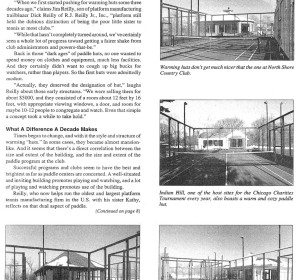Paddle Huts – an important part of the social aspect of the game
Early on it was recognized that a place for players to gather to watch play and socialize was an important part of the game. They started off as simple shacks, but have slowly blossomed into fancy edifices.
It didn’t happen overnight. And they’re still not exactly on equal footing with golf and tennis clubs. But platform tennis facilities were rapidly becoming more than just a few dozen two-by-fours slapped on top of a ring of cinder blocks.
“When we first started pushing for warming huts some three decades ago,” claims Jim Reilly, son of platform manufacturing trailblazer Dick Reilly of R.J. Reilly Jr., Inc., “platform still held the dubious distinction of being the poor little sister to tennis at most clubs.While that hasn’t completely turned around, we’ve certainly seen a whole lot of progress toward getting a fairer shake from club administrators and powers-that-be.”
Back in those “dark ages” of paddle huts, no one wanted to spend money on clothes and equipment, much less facilities. And they certainly didn’t want to cough up big bucks for watchers, rather than players. So the first huts were admittedly modest.
“Actually, they deserved the designation of hut,” laughs Reilly about those early structures. “We were selling them for about $5,000, and they consisted of a room about 12 feet by 16 feet, with appropriate viewing windows, a door, and room for maybe 10-12 people to congregate and watch. Even that simple a concept took a while to take hold.”
What A Difference A Decade Makes.
Times began to change, and with it the style and structure of warming “huts.” In some cases, they became almost mansion-like. And it seems that there’s a direct correlation between the size and extent of the building, and the size and extent of the paddle program at the club.
Successful programs and clubs seem to have the best and brightest, as far as paddle centers are concerned. A well-situated and inviting building promotes playing and watching, and a lot of playing and watching promotes use of the building.
Reilly, who now helps run the oldest and largest platform tennis manufacturing firm in the U.S. with his sister Kathy, reflects on that dual aspect of paddle. “We all know how important the social aspect of the game of platform is,” remarks Reilly in analyzing the changing nature of warming huts. “As Hemingway might say, a clean, well-lighted place is a necessity for the important side aspects of the game, joining together for drinks and discussion and watching others enjoy the game.”
Some of the oldest paddle centers are found in the East, which makes sense since that’s where the game first began. While many clubs boast solid facilities, “new” and “growing” are not words often associated with most club venues. Especially in the earlier paddle days, capital investments were hard to come by for erecting facilities, and more effort and money was focused on the courts themselves, rather than the ancillary areas. As paddle spread and new hot spots erupted, however, the entire paddle package became a concern.
Midwest Boasts A Bevy Of Beauties.
Clubs in different sections of the country, including the upper Northeast and Midwest especially, learned their lessons well from the early-day creations and began fashioning facilities that were complete entertainment packages. Now it’s not unlikely to see bathrooms, kitchens, wet bars, televisions, fireplaces, even hot tubs at the newer palatial paddle places.
“While the Midwest doesn’t have an exclusive on impressive facilities, it does have a host of them,” explains Reilly, speaking from first-hand experience. “We’ve been lucky in being asked to erect some really well-thought-out and sometimes quite expensive ‘huts.’ Some of these structures are going for $200,000 to $300,000 and are really elaborate, with upper stories and stone fireplaces and magnificent light fixtures.”
But the size of the hut doesn’t matter to most paddlers as much as the warmth within. While strong structures contribute to strong programs, it’s the people involved in those programs that really make them go.
Source: Platform Tennis News, Fall 1998




